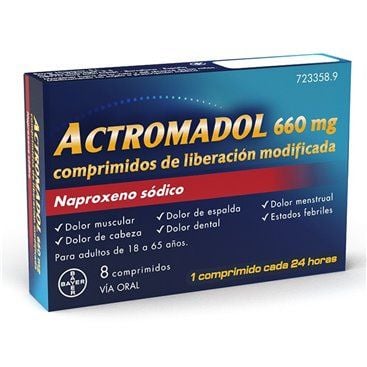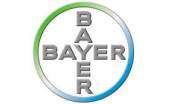Actromadol 660Mg 8 Tablets Modified Release
Actromadol 660 mg tablets provide 24-hour relief for mild to moderate pain, including headaches, muscle aches, and menstrual cramps. With naproxen sodium as the active ingredient, it combines effective pain relief with a convenient once-daily dose. Ideal for adults aged 18-65. Buy online at parafarmacia-online.com.
Actromadol 660 mg tablets provide 24-hour relief for mild to moderate pain, including headaches, muscle aches, and menstrual cramps. With naproxen sodium as the active ingredient, it combines effective pain relief with a convenient once-daily dose. Ideal for adults aged 18-65. Buy online at parafarmacia-online.com.
Actromadol 660 mg Modified Release Tablets ( Naproxen Sodium)
Actromadol Tablets 660 mg: What is it and what is it used for?
Actromadol 660 mg tablets are a pain reliever and anti-inflammatory medication from Bayer, containing 660 mg of naproxen sodium. This nonsteroidal anti-inflammatory drug (NSAID) provides 24-hour relief for mild to moderate pain, such as:
- Headaches.
- Muscle pain and strains.
- Lower back pain (lumbago).
- Menstrual cramps.
- Dental pain.
- Fever episodes.
If you're looking for effective, long-lasting pain relief, Actromadol tablets are an excellent choice for adults aged 18 to 65.
How does Actromadol 660 mg work?
The active ingredient in Actromadol 660 mg, naproxen sodium, works by blocking the production of certain chemicals in the body that cause inflammation, pain, and fever.
Thanks to its modified-release formula, this medication ensures consistent pain relief for a full day with a single dose.
Actromadol 660mg Ingredients
Each Actromadol tablet contains:
- 660 mg of naproxen sodium, equivalent to 600 mg of naproxen and 60 mg of sodium.
- Known excipients: 41.78 mg of lactose monohydrate per tablet.
For a complete list of ingredients, consult the product leaflet.
Who can take Actromadol?
Actromadol tablets are recommended for:
- Adults aged 18 to 65 suffering from occasional mild to moderate pain or fever.
Do not use Actromadol if:
- You are under 18 years old.
- You are over 65, unless specifically advised by a doctor.
How to take Actromadol tablets
- Recommended dose: Take 1 tablet every 24 hours (660 mg). Do not exceed this dose.
- How to take: Swallow the tablet whole with a glass of water. Taking it with food or milk is advisable if you experience stomach discomfort.
- Duration: Stop using Actromadol once the pain or fever subsides. If symptoms persist for more than 5 days (pain) or 3 days (fever), consult your doctor.
Actromadol Side Effects
Like all medications, Actromadol tablets may cause side effects. The most common include:
- Nausea, stomach pain, or indigestion.
- Drowsiness or dizziness.
- Rarely, serious gastrointestinal or cardiovascular issues.
If you experience any severe or unexpected side effects, discontinue use and seek medical advice.
Actromadol Reviews
Users of Actromadol tablets praise its effectiveness in relieving pain and its convenient once-daily dosing. Its 660mg ingredients provide sustained relief for various types of discomfort, making it a trusted choice for many.
Actromadol Price and Where to Buy
Looking for the best Actromadol price? Purchase Actromadol 660 mg tablets online at parafarmacia-online.com to enjoy benefits like:
- Fast and secure delivery.
- Authentic Bayer products.
- Affordable pricing and exclusive deals.
Order now and experience fast, effective pain relief!
6. PHARMACEUTICAL INFORMATION
6.1. List of excipients
Microcrystalline cellulose,
Povidone,
Purified water,
Talcum powder,
Magnesium stearate,
Hypromellose 2208,
Lactose monohydrate,
Anhydrous colloidal silica,
Hypromellose 2910,
Titanium dioxide (E171),
Indigo carmine aluminum lake colorant (E132),
Macrogol 8000,
Carnauba wax.
6.2. Incompatibilities
Not applicable.
6.3. Period of validity
3 years.
6.4. Special precautions for storage
It does not require any special storage conditions.
6.5. Nature and contents of container
Packs of 4 and 8 modified-release tablets.
Aluminum / Polyester envelopes containing 4 tablets each.
6.6. Special precautions for disposal and other handling
Disposal of unused medicine and all materials that have been in contact with it will be done in accordance with local regulations, or it will be returned to the pharmacy.
7. MARKETING AUTHORIZATION HOLDER
Bayer Hispania, SL
Av. Baix Llobregat, 3-5
08970 Sant Joan Despí (Barcelona)
Spain
8. MARKETING AUTHORIZATION NUMBER (S)
83.348
9. DATE OF FIRST AUTHORIZATION / RENEWAL OF THE AUTHORIZATION
August 2018
10. DATE OF REVISION OF THE TEXT
October 2018



